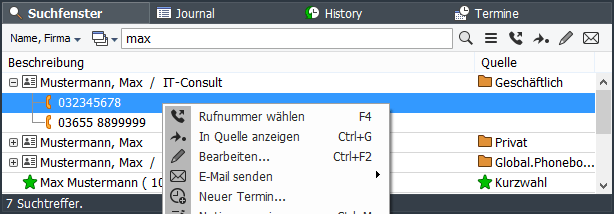The global search function enables centralized search in various components and data sources. By selecting a source filter and a field filter, you can determine in which data sources and in what fields is to search.
Search window
The number of search window can be freely configured. The default configuration contains already a search window. The pop-up search window can also be embedded as a tab window (see Window Management...). To display a search window, select the appropriate entry in the main menu [Window], or activate the corresponding tab.
Wichtige Hinweise zu:Direkte Suche in Datenquellen mit Abfragelimit (z.B. LDAP-Server)...
Field filter
Via the first button to the left of the search box you can select a field filter by drop down menu. The selected filter determines that only in the appropriate fields (field types or field name) is searched. Sie können vorhandene Filter bearbeiten und neue Filter hinzufügen.
To edit the field filter, select the appropriate menu item in the filter menu, or open the configuration from the main menu [Options > Search].
More information to configuring...
Source filter
By the second button - immediately to the left of the search bar - you can select with a drop-down menu in which data sources is to be searched. In addition to the "Available Sources" also custom source filter can be selected from this menu.
Add custom source filter: You can create your own source filter for example to define a specific combination and search order of selected data sources.
To edit the source filter, select the appropriate menu item in the source filter-menu, or open the configuration from the main menu [Options > Search].
More information to configuring...
Function of the search line
The search line supports the following functions:
Mehrwortsuche: If you are searching for multiple terms, they must be separated by a space. All terms are searched by a logical AND operation. Enthält der Suchbegriff selbst Leerzeichen, so muss dieser in Anführungszeichen gesetzt werden. If a search term starts with a "-", only search results that do not contain that term will be displayed.
Example1: "max muster" searches for "max* AND muster*".
Example2: "max -muster" search for "max* AND NOT muster*".Search by word beginning or full text: The "Search at the beginning of word" search mode can be set in the context menu of the search bar. If it is disabled, the "full text" search mode will be used. Additionally, the search mode for each search term can be controlled by using "regular expressions".
Search with regular expression/wildcards:
Supported expressions Description Searchtext* oder <Searchtext Search for word beginning *Searchtext* Search anywhere in the text (full text search) *Searchtext Search word end <<Searchtext Search by field begin -Search text The search term was not found. * Wildcard for any number of characters ? Wildcard for exactly one character Search with and without case-sensitive: If a search term is entered entirely in lowercase, case sensitivity will be ignored. Includes a search term uppercase letters, searching is carried out case-sensitive.
Suche automatisch starten: Ist dieser Modus aktiviert, startet die Suche automatisch während der Eingabe des Suchbegriffes. Anderenfalls startet die Suche erst nach Betätigen der Entertaste. Der Startmodus kann über das Kontextmenü der Suchzeile festgelegt werden.
In der Grundkonfiguration ist die "automatische Suche" aktiviert und die Trefferliste auf 200 Einträge begrenzt. Diese Einstellungen können in der Konfiguration des jeweiligen Suchfensters angepasst werden.
Zurücksetzen/Löschen der Suchzeile: Der Inhalt der Suchzeile kann durch ein einfaches betätigen der Taste "Entfernen" gelöscht werden, wenn der Eingabe-Cursor hinter dem letzten Zeichen steht. Dabei werden auch die Suchtreffer in der Ordneransicht zurückgesetzt.
Keyboard navigation in the search window:
To to navigate between search field and hit list, you can use the cursor keys as follows:
The input focus is on the search line: Cursor key Action Down Moves to the top of the hit list Up Moves to the end of the hit list The input focus is on the hit list: Cursor key Action Down Navigation within the hit list. If the last entry is selected, the focus moves to the search line. Up Navigation within the hit list. If the first entry is selected, the focus moves to the search line. Left A possibly open branch in the tree is closed. Otherwise, the focus moves to the search line. Right A possibly closed branch in the tree is opened. There is no focus change to search line. Apply actions on search results:
For an entry selected in the list of results, one or more actions may be available. These actions can be accessed through the buttons or the context menu.
Search-Hit Actions: Show in source To display the search result in its data source, e.g. the corresponding folder is opened in the phonebook window and the entry is selected. dial the phone number If a phone number is available, it can be dialed directly. Edit Opens the "Edit" dialog of the corresponding element (eg the phone book data mask). Send email Allows you to directly send an email if the search result contains one or more email addresses. From program version 3.0.000 the search function is available for the following components:
- PhoneBook
- Speed Dial
- Appointments
Hint: The Journal offers its own search function by F3.
Search in PhoneDialog

Another way for global search provides the combined input and search line in the PhoneDialog. The hit list is displayed as a pop-up list and is limited to a maximum of 40 search results. It is used a specified source filter for phonebook + speed dial. The search fields filter can be adapted under [Options > Telephony].
More information on searching in the PhoneDialog...
Configuration
The configuration of the search can be opend via main menu [Options > Search] or via the context menu of the Search window.
Help for configuring the search function...
